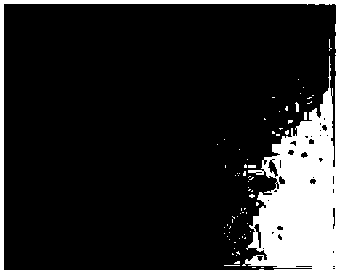Application of tea polyphenol and derivatives thereof in prevention of schistosoma japonicum katsurada infection
A technology of derivatives and tea polyphenols is applied in the application field of tea polyphenols and derivatives thereof in preventing Schistosoma japonicum infection, and can solve the problems of complex extraction steps of plant active components, difficult control of application concentration, and high cost, and achieves reduced Skin-piercing function, prevention of percutaneous infection of Schistosoma japonicum, and less toxic and side effects
- Summary
- Abstract
- Description
- Claims
- Application Information
AI Technical Summary
Problems solved by technology
Method used
Image
Examples
Embodiment 1
[0026] Detection of the effect of EGCG on the activity of cercariae
[0027] About 40 cercariae of Schistosoma japonicum were counted and placed in distilled water, 1% EGCG, 0.1% EGCG, and treated for 2-10 minutes, and then the activity of cercariae was observed under a dissecting microscope. The results are as follows:
[0028] refer to figure 1 and image 3 , after the cercariae were exposed to 1% EGCG for 2 minutes, the movement of the cercariae was significantly stronger than that of the control group, and the tail swung sharply and contracted. refer to figure 2 and image 3 , 0.1% EGCG group and the control group have no particularly large difference.
Embodiment 2
[0030] Effect of EGCG on cercariae infection (adult worm count and liver pathology)
[0031] Experimental mice were randomly divided into 3 groups: distilled water control group, cercariae treated with 1% EGCG group, cercariae treated with 0.1% EGCG group, 5 mice in each group. Before the experiment, the abdomen of the mice was shaved (range 2cm×3cm); 0.1ml of 10% chloral hydrate was injected subcutaneously for anesthesia. The cercariae (30±5) of Schistosoma japonicum treated with distilled water, 1% EGCG, and 0.1% EGCG for 10 minutes were taken respectively, pasted on the abdomen of mice in the three groups, and infected for 20 minutes.
[0032] 1) Adult count
[0033] The mice were dissected 43 days after infection, and the worms were collected by perfusion and shredding. Firstly, the superior vena cava was perfused and washed, and the number of worms in the liver and intestinal venous plexus was counted under the dissecting microscope; after the lavage was completed, the ...
Embodiment 3
[0042] Effect of EGCG on cercariae infection (ELISA test)
[0043] (1) Separation of blood serum from mouse eyeballs, diluted 1:10 for later use
[0044] (2) Take a 96-well reaction plate, add 100 μl sample diluent to each reaction well, and keep 2 positive and negative control wells and 1 blank control well;
[0045] (3) Add 10 μl of serum to be tested at 1:10 to the wells of the existing sample diluent, and mix well;
[0046](4) Add 100 μl blank, negative and positive control sera to the previously reserved wells;
[0047] (5) Add sealing film after mixing, and incubate in a 37°C incubator for 30 minutes;
[0048] (6) Discard the liquid in the reaction well, then fill up with washing solution, let it stand for 5 seconds, then shake it dry, repeat 5 times and then pat it dry;
[0049] (7) Add 2 drops of enzyme conjugate to each well, mix well, cover with sealing film, and incubate in a 37°C incubator for 30 minutes;
[0050] (8) Repeat step (5);
[0051] (9) Add 1 drop o...
PUM
 Login to View More
Login to View More Abstract
Description
Claims
Application Information
 Login to View More
Login to View More - R&D
- Intellectual Property
- Life Sciences
- Materials
- Tech Scout
- Unparalleled Data Quality
- Higher Quality Content
- 60% Fewer Hallucinations
Browse by: Latest US Patents, China's latest patents, Technical Efficacy Thesaurus, Application Domain, Technology Topic, Popular Technical Reports.
© 2025 PatSnap. All rights reserved.Legal|Privacy policy|Modern Slavery Act Transparency Statement|Sitemap|About US| Contact US: help@patsnap.com



